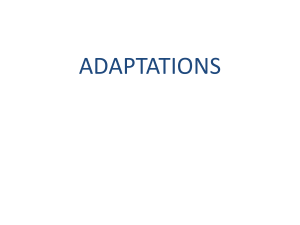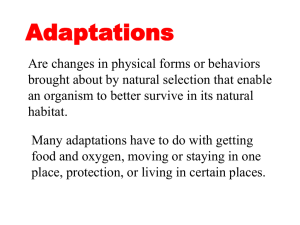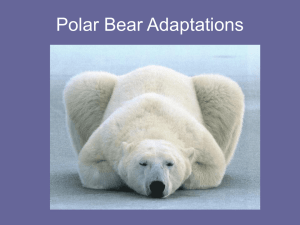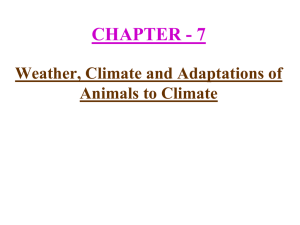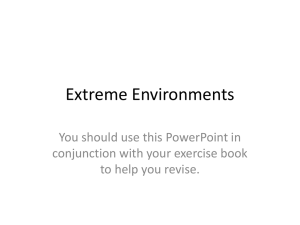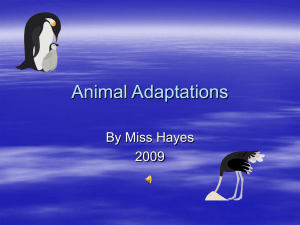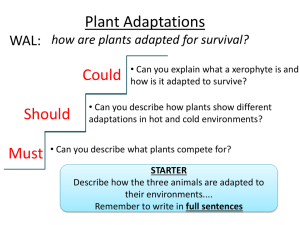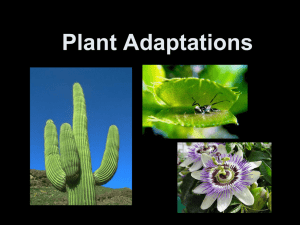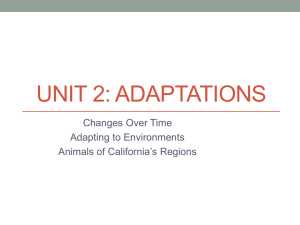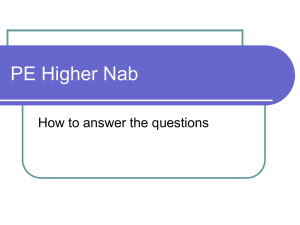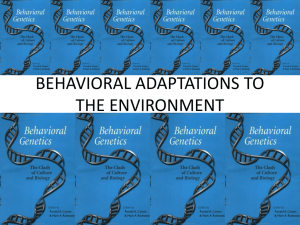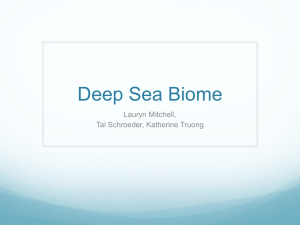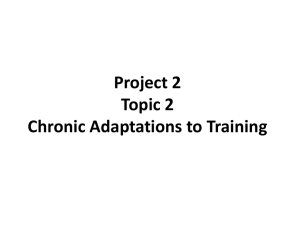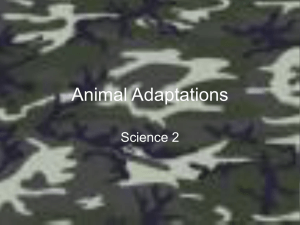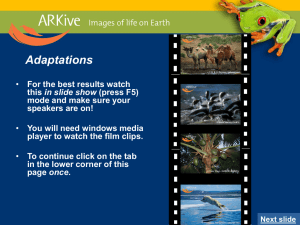Thermoregulation
advertisement
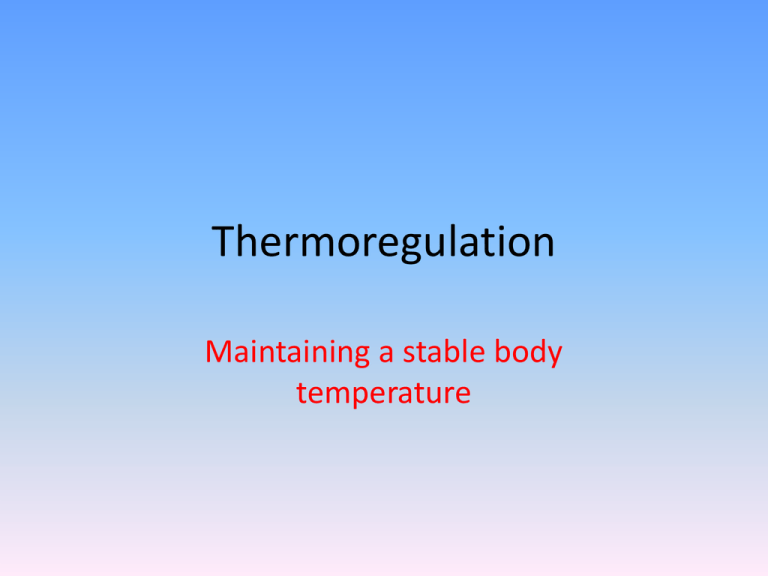
Thermoregulation Maintaining a stable body temperature • Why do organisms need to maintain a stable body temperature?? Optimum Temperatures • Organisms must keep their body temperature between a specific range in order to survive. • Enzyme activity • Metabolic processes Body Temperature in animals • There are two types of organisms that maintain their body temperature in very different ways • Ectothermic organisms • Endothermic organisms • What do these terms mean? Can you give some examples of each? Ecto (outside); therm (heat) • Use external environment to maintain body temperature. • Produce little heat • Lose heat quickly • Use less energy • Become very inactive when it gets cold • Fish, Reptiles, Insects Endo (inside); therm (heat) • Maintain relatively constant body temperature • Generate a lot of heat from within via internal heat production • Generally have insulating structure to reduce heat loss (e.g. feathers, fur, fat) • Also develop behavioural and physiological adaptations to prevent heat loss Endo (inside); therm (heat) • Mammals and birds • Homeothermic: organisms that can maintain a stable body temperature (e.g. mammals) • Poikilothermic: organisms whose body temperature varies considerably due to its surroundings (e.g. reptiles and insects) Heat Transfer • Heat is a question of balance • Too HOT and animals must find ways to lose heat • Too COLD and animals must find ways to gain heat Heat Transfer • To understand why animals do the things they do you must understand how heat can be transferred. QUESTION • What are the ways in which heat can be transferred?? How can animals lose or gain heat?? Heat Transfer • Conduction: transfer of heat from a hotter object to a cooler object via contact. • Radiation: transfer of heat from a hotter object to cooler object via infra-red waves. Heat Transfer • Convection: Transfer of heat by warm air, or water, rising and being replaced by cooler air or water. • Evaporation: The process of changing a liquid into a gas. The heat from the body can evaporate water and cause a cooling effect. Heat Transfer Heat transfer RAP!!!! Heat Gain and Loss • Gain – Basic metabolic processes – Shivering – Exercise or other muscular activity – Radiation and conduction to the body • Loss – Evaporation sweat – Panting – Convection – Radiation and conduction from the body Heat Loss and Gain VIDEO!!!!! Systems Involved • Thermoregulation occurs via nerves and hormones • It involves many sensory inputs and several effector responses that act together to maintain a stable temperature Linking to other systems • Thermoregulation is strongly related to the Nervous system and the Endocrine system Worksheet Investigating Sweating What you need to know: How does sweating affect body temperature? Why does sweating affect body temperature? How can models help us investigate how the body works? Question: How does water evaporate? For water to evaporate, it must absorb heat from its surroundings Dry towelling cloth Cotton wool Set up the equipment as shown opposite Fill the conical flask with hot water from the kettle Record the temperature and start your stop clock Record the temperature every minute for 10 minutes. Record your data in a suitable table Time (mins) Repeat with a wet towelling cloth 0 (START) 1 Temperature (°C) Dry Flask Wet Flask To Do: Plot a graph of your data Which flask cooled faster? How do you explain your results? Was your experiment a fair test – if not, why not? How could you make this experiment more of a fair test? Systems Involved • Brain – Hypothalamus • Lowering or raising the temperature of the hypothalamus initiates regulatory responses • Changes occur in heat production and heat exchange • Temperature cells act as misalignment detectors Core body temperature >37°C Thermoreceptors Hypothalamus nerves Muscles reduce activity Sweat glands increase secretion Muscles of skin arteriole walls relax Skin arteries dilate More blood to the skin. More radiation & conduction of heat More water covers the skin. More evaporation Less heat generated Systems Involved • Hypothalamus responds to receptors and coordinates appropriate nerve and hormonal responses Systems Involved • The hypothalamus can release hormones that initiate the release of further hormones. • For example as the temperature drops the pituitary gland will be stimulated and release a thyroid stimulating hormone • The thyroid gland in turn produces hormones which increase the metabolic rate therefore increasing heat production Systems Involved Systems Involved • Skin – thermoreceptors act as disturbance detectors. • Detect change in external environment and triggers responses before it effects internal body temperature. • Responses include erector muscles of hairs contract and hairs stand up, blood vessels constrict. • These are the effectors for mediating change. Skin Negative feedback • Temperature regulation by the skin is part of a negative feedback system. • Output is fed back to receptors and becomes part of a new stimulus response cycle. NEGATIVE FEEDBACK Thermoreceptors Core body temperature >37°C Thermoreceptors Blood temperature Muscles of skin arteriole walls relax nerves Hypothalamus Sweat glands increase secretion Muscles reduce activity Body loses heat Return to 37°C Thermoregulation • VIDEO REVIEW Summary • • • • • Ectothermic Endothermic Homeothermic Poikilothermic Heat transfer – Conduction, Convection, Radiation & Evaporation • Heat Gain and Loss • Endocrine and Nervous system involved Review Questions • Page 256 of the text book. - Questions 17 - 21 Adaptations and Thermoregulation • Apart from physiological adaptations, animals also develop behaviours and physical structures that help them regulate their body temperature. Heat Loss and Gain • Must remember the ways in which heat can be transferred. • These processes work on a temperature gradient. • Can you explain what this means? Heat Loss and Gain • Temperature gradient simply refers to the difference in temperature between two things. • For example the lizard and the rock. Heat Loss and Gain Heat Loss and Gain • The rock is warmer than the lizard so the heat moves, via conduction, from the rock to the lizard. • As the lizard heats up and the gradient decreases and eventually changes the heat moves from lizard to rock. Structural & Behavioural • The transfer of heat needs to be controlled. • What examples of structural and behavioural adaptations can you think of? Behavioural Responses • Penguins huddling • Burrowing underground • Seeking shade • Basking • Fanning from honeybees Behavioural Responses • VIDEO Counter current heat exchange Counter current heat exchange • The arteries and veins in certain areas, like the foot of the penguin, run very close to each other. • The warmer blood in the arteries heats the cooler blood in the veins. Structural Responses • Animals need to control exchange. This can also be achieved through: • Insulation: - Fur - Feathers - Fat Structural Adaptations • Feathers and fur insulate by trapping a thick layer of warm air next to the skin. • The layer of air has a protective insulating affect keeping the animal warm. Structural Adaptations • The layer of air trapped by the otters fur helps reduce the temperature gradient between the otter and its surroundings. • Therefore reducing heat loss and gain. Structural Adaptations • Blubber is also used as insulation. • Thick layers of fat are very effective in insulating animals against extremely cold conditions. Structural Adaptation • Shape and size also play an important role. • How do you think shape and size of an animals can help? Structural Adaptations • A large surface area to volume ratio increases heat loss • A small surface area to volume ratio reduces heat loss. Structural Adaptations Structural Adaptations • So being larger and rounder in shape is beneficial in a cold climate. • For example whales and seals • Being smaller is better for individuals in hot climates. Shutting Down • Sometimes these adaptations are not enough. • The external temperature can reach such a point that the internal temperature of animals reaches a critical level Shutting Down • The external temperature at which metabolic activity begins to rise is called the lower critical temperature • The increase in metabolic rate means the animal needs more energy. • This can often be too difficult to find. Shutting Down • At this point animals will often go into hibernation to conserve energy. Shutting Down • The upper critical temperature refers to the point at which cooling mechanisms fail. • The metabolic rate rises with the increase in the external temperature. This an be very dangerous. Shutting Down Summary • Explain how behavioural adaptations help regulate body temperature using specific examples. • Explain how structural adaptations help regulate body temperature using specific examples. • Explain how counter current heat exchange works Adaptations • Design your own animal (groups of 3) • Choose an environment (extreme HOT or extreme COLD) • Draw and label adaptations that help it survive • Include physiological, behavioural & structural (physical) • Present to the class!!! • Give it a name (be creative) • Think about possible adaptations for water balance. BINGO Thermoregulation, Osmosis, Radiation, Convection, Freshwater Fish, Poikilothermic, Insulation, Pituitary Gland, Ectotherm, Hypothalamus, Conduction, Counter Current heat exchange, Homeothermic, Marine Fish, Endotherm, Receptors, Evaporation, Loop of Henle, Thyroid Gland, Hibernation, Shivering, Dilation of Blood Vessels.
